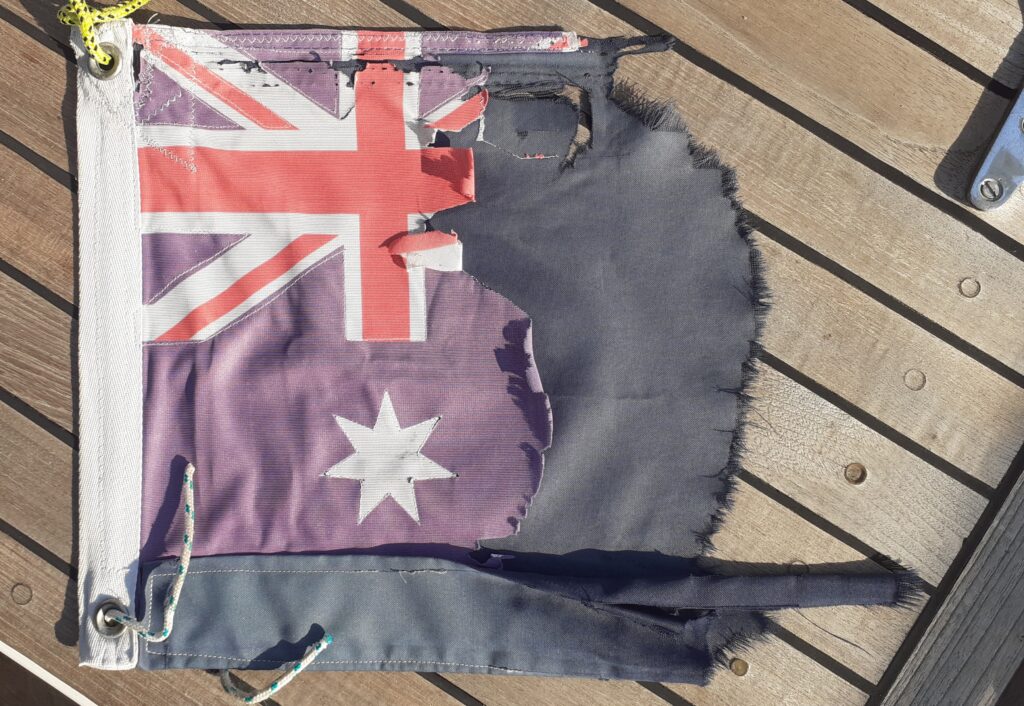Until now leaving a country has been an easy experience. You visit some official and tell him you want to leave, he stamps your passport and gives you a clearance paper and then you leave.
In Darwin you have to give the Australian Border Force notice of leaving so that they can fit you in to their busy schedule. They are protecting the borders 24 hours a day, 365 days a year but you can only leave on workdays but not on Monday and only in the morning when it is not too hot. And not before 08:30 to give them time to get warmed up. They insist on coming to the boat but will only do so at one place in the whole of Darwin.

Only a bit late, two border force agents turned up at the appointed dock wearing matching black boots, trousers and shirts – sort of 1940s storm trooper look. One was friendly and polite but either hard of hearing or didn’t listen while the other had a 50% failure rate correctly identifying our two passports. But together we quickly achieved the necessary paperwork, received a plastic pen and floating key ring (both made in China) and were free to leave Australia.
The tide was going out so we left the dock, hoisted a sail and drifted out in to the Beagle Gulf making five knots towards Indonesia. Three hours later the current was slowing but we tacked in to the wind heading west and then, before we hit the sand banks, tacked again to use tide and wind to sail north. The water was flat, the breeze was fresh and we were making five knots. Unfortunately Melville Island was directly in our way so we had to turn again. Now we had the wind and tide against us and spent the rest of the afternoon and night travelling 71 miles to achieve a distance of 23.

The wind was obviously set on coming from the west so at dawn we turned east to sneak through the narrow Howard Channel. This “shortcut” has to be taken at exactly the right time so that you are not fighting the tide and is definitely not somewhere you want to be in an east wind. The right time was 18:00 which gave us seven hours to make 21 miles. Heidi looked at our average speed of 0.8 knots and laughed out loud on hearing this.
We had south wind. We had north wind. We had currents against us and then with us. We skirted a fish farm and finally we were heading in to an east wind and considered abandoning the attempt but the weather forecast said it would disappear as we got there so we continued. We passed the start marker ten minutes early and felt the current start to suck us. Just after dark everything was wonderful with a wind from the north so Neill lay down in the cockpit and Heidi continued through the night.
After about two hours the sails began to flop as a 15 knot east wind (yes, the east wind you really don’t want) hit us right on the bow. 15 knots of wind against four knots of tide in a shallow channel produced huge waves which threw Artemis around so we took over hand steering through the black night. With Neill on the tiller Heidi had to navigate, run the galley and negotiate with a fishing boat “who was passing who where” on the marine radio. She also had to be the relief helmsman, trying to maintain a course of fifty degrees through fluid chaos. The wind remained strong against us until one in the morning when Heidi collapsed for two hours sleep before taking over to let Neill sleep. By three o’clock we were becalmed in the Van Diemen Gulf and frustratedly looking for wind to take us to the next tidal gate to continue north. Four hours later and still there was not a breath of wind so, with heavy hearts, we put the engine back on to reach the open sea where we finally found a breeze to carry us north with about one knot.
We sailed everything we could but still had the engine running for 24 hours during our 54 hour odyssey. Never before, not even in the Panama Canal or south of Tasmania, have we used so much engine. But as I write this we are sailing north across the Timor Sea and life is good again. Australia was just trying to stop us leaving.


Wow. That sounds like hard work.